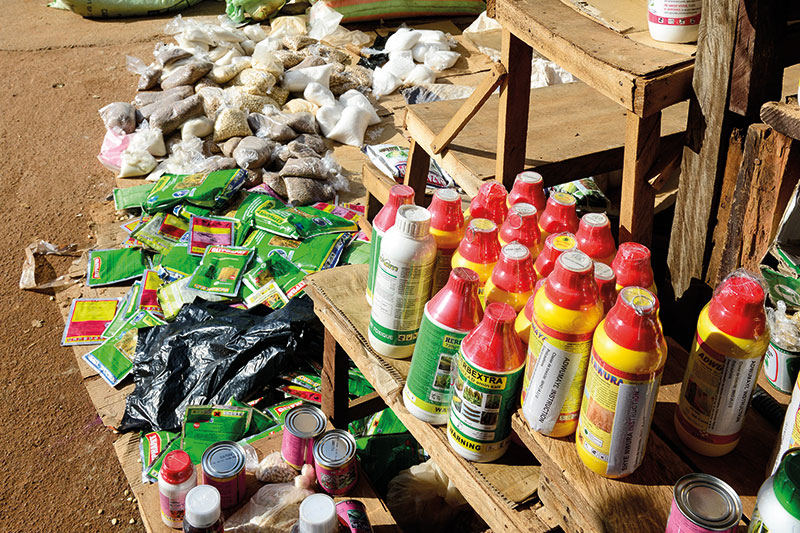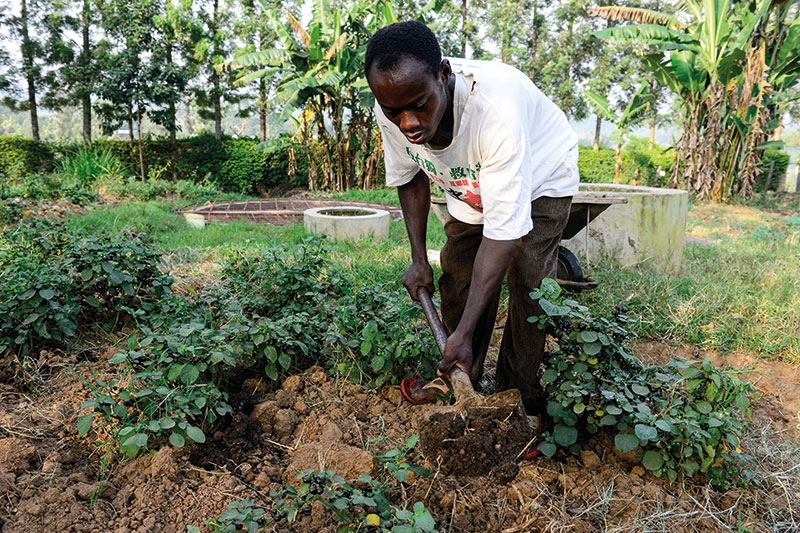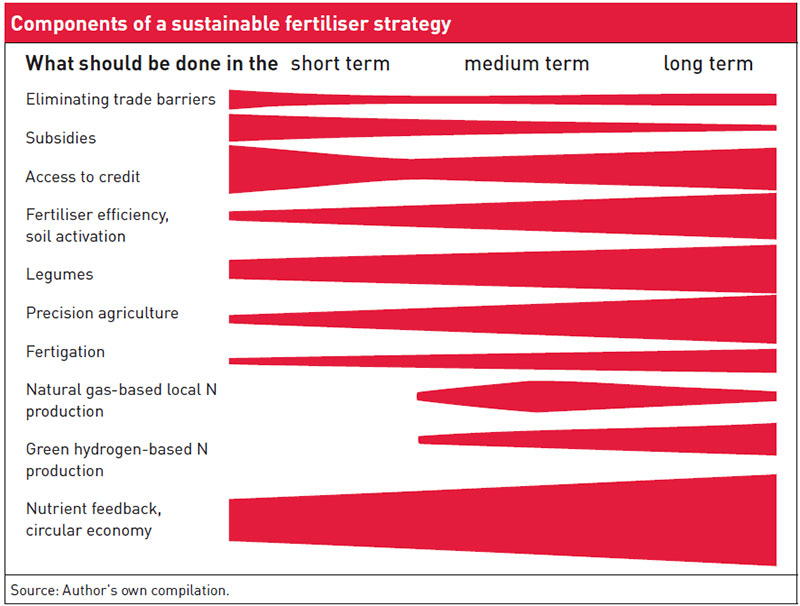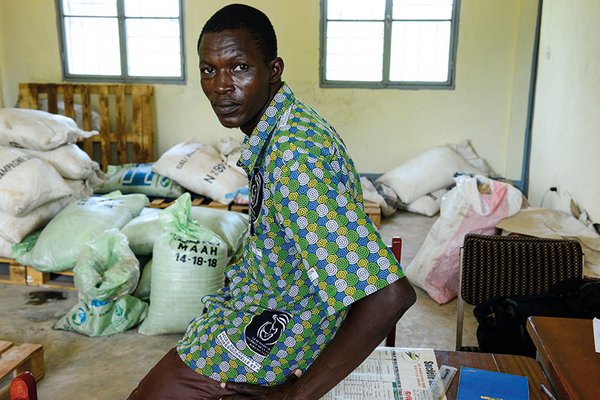Long-term fertilisation strategies for blended agricultural sustainability are needed
The majority of a total of more than 800 million food-insecure people live in smallholder households. As long as these people cannot move on to activities which are not dependent on agriculture, which is unlikely for most for the foreseeable future, an increase in their area and labour productivity remains the most important approach to more income and thus to food for the majority of those going hungry. At the same time, the intensification of smallholder farming represents a contribution to more food availability and more stability, to economic growth especially in rural regions and to a reduction in land pressure in natural reserves. The key argument is that it is income and not food production per se which assures their food security. Of course, for resilient livelihoods additional mechanisms also play a role, such as diversification, access to financial services and stable food markets.
Better availability of plant nutrients is crucial for enhanced agricultural productivity. So far, in modern agriculture, mineral fertiliser played a dominant role in that. Some estimates put around 40 per cent of global yield increases down solely to the increased use of mineral nitrogen, the most important plant nutrient. It is difficult to view the contribution of other macronutrients – phosphate and potassium – as well as micronutrients like boron, iron or zinc separately from that of nitrogen, with micronutrients being particularly important among higher-value and vulnerable vegetable and fruit varieties and for plant health and quality. And then there is lime, which is frequently added to raise the pH value and thereby nutrient availability of the soil. All in all, mineral fertilisers are said to account for up to 60 per cent of modern production progress, usually in conjunction with modern plant varieties necessary for higher take-up, use in the plant and concomitant changing plant health situation.
Strong correlation between fertiliser and food prices
Given the considerable importance of mineral fertilisers, it is no surprise that the correlation between international fertiliser and food prices has historically been very marked. The current food price crisis, too, has a fertiliser component. Since mid-2020, i.e. already before the Ukraine war, fertiliser prices had risen strongly, showed another sharp increase at the beginning of the war, and now, in mid-May 2023, they are back at the pre-war level, but are two or three times higher than they were before 2020. It is difficult to express in numerical terms just how large the contribution of fertiliser prices to the rise in food prices and the hunger problem really is, for this relationship depends on a large number of factors which interact. The cost-benefit ratio of using fertiliser varies depending on the respective location, crop and level of fertilisation. The less is used, the higher the yield loss tends to be according to the law of diminishing yield increase. Furthermore, other relevant prices change too, especially that of energy, which plays an important role for the food prices in various forms for production, processing, warehousing and transportation of fertiliser and agricultural products. The joint correlation of global energy, fertiliser and food prices is very close.
Severe price fluctuations are very problematic for the farmers. After all, they have to pay for fertiliser in advance, at a stage when they do not know what the agricultural prices will be after harvest.
Smallholders likely to react particularly sensitive to high and variable fertiliser prices
In poor developing countries and among smallholders, the fertiliser price crisis is further aggravated by a number of factors. Even if the price relations are an incentive to produce more, the farmers can hardly afford the higher fertiliser costs with their own reserves, and even if they do have access to credit, it is very expensive. Moreover, for various reasons, smallholders are particularly risk-averse, and insurances and price-hedging are virtually non-existent in developing countries. So on average, smallholders will take fewer risks and are most likely to apply less fertiliser if prices rise. Since their use of fertiliser is usually very low (the African average, for example, is below 20 kg/ha, compared with the global average of approx. 140 kg/ha), their drops in yield accompanying diminishing fertiliser use are particularly high. This explains why, in May 2022, the President of the African Development Bank warned that fertiliser shortages could lead to a 20 per cent decline in food production on the continent.
In order to attempt an assessment of the current fertiliser crisis despite the issue’s complexity as described above, a study which appeared in the specialist journal NatureFood is cited in the following which tried to isolate the effects of fertiliser costs and trade restrictions in a model calculation: “We show that, combined, agricultural inputs costs and food export restrictions could increase food costs by 60–100 per cent in 2023 from 2021 levels, potentially leading to undernourishment of 61–107 million people in 2023 and annual additional deaths of 416,000 to 1.01 million people if the associated dietary patterns are maintained. Furthermore, reduced land use intensification arising from higher input costs would lead to agricultural land expansion and associated carbon and biodiversity loss.”
The debate over mineral fertiliser
Individual governments and the international community have resorted to a wide range of measures to mitigate the current food crisis. Alone the World Bank announced in April 2022 “that it is making up to $30 billion available over a period of 15 months, including $12 billion in new projects”. For this purpose, in addition to support from already existing funding lines, the International Monetary Fund (IMF) has set up a new “food shock window under the emergency financing instruments”.
However, the current crisis has also exacerbated already heated up debates over a transformation of agricultural production and even “the” (global) food system. This applies in particular to the role of external fertiliser. To critics, very high rates of fertiliser application are a synonym for ecologically non-sustainable “industrial” agriculture – linked with the eutrophication of water bodies, breaching of planetary boundaries, greenhouse gas emissions and the degradation of soil quality. To advocates of this type of agriculture, external fertiliser use is not only a key means of achieving high yields, but also serves to limit the degradation of cropland through soil mining and the expansion of cultivated land, thus contributing to preserving biodiversity outside such land.

Herbicides, seeds and fertiliser on a market stand in Gaoua, Burkina Faso. Photo: Jörg Böthling
While both views have good arguments, the scientific bottom line is that sustainable agricultural production requires the nutrients drawn from the soil with the harvest to be added to it again, whether naturally, via soil weathering, sediments and the atmosphere or by human action, with organic and/or mineral fertiliser. This equation contains many variables which vary from location to location, such as soil quality and the mobilisation of nutrients, external inputs from the atmosphere or from the natural environment via livestock keeping, nitrogen enrichment with legumes from crop farming or agroforestry, the degree of nutrient circularity on the farms, but also losses through insoluble fixation in the soil, leaching and outgassing. The degree of marketing among the farms is also of considerable significance. The more produce leaves a farm and enters the market, the more the circularity on a farm is disturbed, and the earlier external nutrients have to be added to make up for net losses.
However, for smallholders, market production is an essential element to overcome poverty and attain higher income enabling an acceptable quality of living. For example, yield in sub-Saharan Africa is usually at less than 20 to 30 per cent of the yield under good agricultural practice, and even with this low level of area productivity, the nutrient balance is usually negative (soil mining). Therefore, with the exception of very fertile and deep-reaching soils, as area productivity and the degree of marketing rise, the additional and external supply of nutrients becomes essential. However, just how strong this supply has to be and where the nutrients come from can make a big difference both for the sustainability of supplies from agriculture, and hence for local resilience, and for the costs and thus the competitiveness of farmers.
Setting the course for a sustainable fertiliser strategy
For long-term sustainable agriculture, fertilising oriented on net nutrient withdrawal with a minimum of losses is desirable, hand in hand with enhanced yields and labour productivity of smallholders. Achieving this requires the following measures:
Redistributing fertiliser intensity and developing a (clean) fertiliser industry. For nutrient withdrawal which cannot be supplied via the practices described in the following, synthetic (this is what nitrogen fertilisers industrially gained from atmospheric nitrogen are often called) and mineral (other fertilisers produced by mining natural soil resources and mixtures of these with synthetic nitrogen) fertilisers will continue to be needed. Whereas the output quantities are far too high in many industrialised countries and certain areas of emerging economies, they are generally too low in poor countries and among smallholders. A global redistribution of fertilising intensity from the Global North to the Global South is therefore needed. For more about what origin of synthetic nitrogen fertiliser is desirable, see below.
In order to reduce the greenhouse gas emissions of nitrogen fertilisers in particular, efforts can be made to develop a synthesis of green hydrogen in the long term, although the necessary methods are still significantly more expensive, even when taking the current gas prices into account.
However, not only the application but also the production of mineral fertiliser ought to be promoted in the Global South. The crisis has shown that dependence on a handful of supplier countries is too high. Now some endeavours are underway to establish an independent fertiliser industry in Africa and use local natural resources, in particular gas and raw phosphate.
Raising energy efficiency. With clever crop sequencing, choosing the right time for application and properly working the organic and inorganic fertilisers into the soil, nutrient losses can be reduced. One major hope is the introduction or improvement of precision agriculture – by precisely placing the fertiliser below the soil surface, in accordance with the respective supply needs of the plants. On large, mechanised farms, this can be achieved with high-tech, using satellite and computer steering of the machines, on small farms with manual application of the fertiliser during or after sowing. Coating or chemically and biologically modifying the fertilisers with the aim of delaying the dissemination of nutrients and improving uptake is to contribute to reducing losses and gaining efficiency.
Improving soil quality. To optimise the use of the nutrients in the soil and those added, activating soil life and raising soil organic matter are crucial. Some tropical soils completely absorb fertilisers without such additional measures, while in most other soils, this improves nutrient supply and storage. This can be achieved by temporally and/or spatially phasing the cultivation of different cultures, by crop-livestock integration, by adding biological substance (residual matters), etc. Lately, there has also been much experimenting with microbial activation of the soil and plant-soil interaction. However, many methods requiring larger amounts of organic matter require conversions in the farming systems and entail investments which are frequently anything but trivial. For larger farms, mechanised methods are a precondition. For small farms, manual methods are required which, however, have to consider peaks in labour input as well as the workload, for even the smallest farms experience labour bottlenecks at certain times. For methods incorporating livestock manure, corresponding stocks of animals and the feed supply are a precondition.

A farmer in Kakamega County, Kenya, using the remains of fermentation from a small biogas plant as compost to improve soil quality. Photo: Jörg Böthling
Growing legumes. The cultivation of legume crops is one particularly frequently mentioned form of substituting mineral fertiliser and improving soil life. In connection with bacteria, these crops can bind atmospheric nitrogen, and depending on the mode of cultivation, they also contribute valuable subsistence and cash crops as well as feed. However, legumes are not always easy to integrate into farms. They are often susceptible to disease and difficult to store, and in the form of trees and shrubs, they soon compete with other crops for water, light and nutrients, while their green mass has to be worked into the fields or transported within the farm and marketing them creates competition with imported products, in particular soy. Looking far ahead, it is conceivable that nitrogen fixation in non-legumes will become possible via genetic engineering, which would facilitate adaptation but present challenges in terms of biosafety and authorisation.
Fertigation. In horticulture, combining irrigation with applying soluble fertiliser is a tried and tested method to effectively disseminate nutrients, although it also entails considerable investments as well as water abstraction and pollution. It will therefore tend to remain a (larger) niche solution.
Developing the circular economy. In the long term, efforts also have to be made to improve not only the nutrient cycles within farms but also to enable the return of nutrients which leave the farms when farm produce is marketed. This is by no means trivial, either, for there are numerous health/ hygiene, logistic/ economic, legal and psychological obstacles. For most of the nutrients are contained in the human faeces. These are enriched with harmful substances, stink, cause revulsion, are watery and are bulky to transport fresh. Ways have to be found to separate and enrich the substances and manufacture accepted products. This can be accomplished at local level in the form of organic fertiliser, which can also bring back nitrogen and organic matter to the soils. Partly, high hurdles have to be cleared regarding possible health hazards, and one partial solution could be restricting application to non-food crops. Nutrient concentration has to be raised for longer transportation routes, e.g. via the biological or chemical extraction of individual nutrients. During the last few years, this has already been achieved on a technologically large scale in the case of phosphate, with developments here being driven by fears of this possibly being the first substance to become scarce at global level. Such fears have since dissipated, which is one reason why the methods are not yet economical.
Developing financing systems, eliminating subsidies
As argued, the respective fertilising strategies which are sustainable in the long term have to be tailored to locational features and cannot be put into practice from one day to the next. Bundles of measures customised to individual farming systems still require a considerable amount of research and local adaptation in cooperation with the farmers themselves. For many measures, markets have to be tapped and supply chains established, which calls for close cooperation with the private sector. For fertilisers and new inputs as well as labour, farmers have to make major investments in the short term, and they have to do so for mechanisation and farm conversions in the long term as well. For this purpose, they require capital (loans) and, in order to safeguard themselves from risks, whenever possible, insurances, as well as saving options. Here, support is needed for making rural finance systems work better.

From an economic angle, longer-term, lasting subsidies should not be resorted to whenever possible, since they usually set the wrong incentives and create considerable costs and risks for the state budget. This is currently becoming apparent for the subsidies for mineral fertilisers, which were introduced in many countries in sub-Saharan Africa following the example set by Malawi in the early 2000s (also see the article on pages 24-26). There, sometimes as much as 20 per cent of the entire state budget has been spent on them. Given the currently high price levels, governments cannot maintain the subsidies, and even in normal times, they absorb so much money that hardly anything is left for research and investments addressing the above-mentioned and other challenges in the agricultural sector. Furthermore, many of the subsidised fertilisers tend to benefit more wealthy farms via the black market because, owing to urgent liquidity problems, the poorest often sell them quickly. However, while long-term subsidies are unsustainable, in the current high price phase, short-term subsidies are appropriate to cope with the crisis as a transitional instrument.
The current crisis offers the opportunity to develop fertiliser strategies which focus on the long-term alternatives, and which, while driving up the non-sustainable subsidies where necessary in the short term, wind them down in the long term. Now it is up to the countries of sub-Saharan Africa to employ the means as efficiently and effectively as possible. They do not have the rich industrial nations’ option to maintain costly subsidy strategies. The EU ought to support such local strategies rather than transferring its own problems with sustainability to the developing countries in an unreflected manner. The European Union’s refusal to support a local fertiliser industry with reference to climate change while simultaneously seeking to secure energy and natural resources world-wide can only be perceived as hypocrisy in the Global South. After all, the respective countries and actors there have greenhouse gas emission levels which have so far been way below the global average, and the reasons for their emissions are probably the most justified ones globally. Saloni Shah notes in the journal Foreign Policy that “Even former United Nations climate envoy Mary Robinson has come around to the idea that African countries should take advantage of their natural gas reserves to meet their energy needs.”
The effort to establish long-term fertiliser strategies may be cumbersome and challenging but is certainly worthwhile. In relation to the economy as a whole or to employment, the agricultural sectors are significantly more important for poor countries than the industry sectors are for rich countries.
Michael Brüntrup is an agricultural engineer who did his doctorate on cotton growing in Benin/West Africa. Since 2003, he has worked for what is now the German Institute of Development and Sustainability (IDOS) in Bonn, Germany, and used to be the German Development Institute (DIE), where he generally deals with agricultural policy and food security issues in sub-Saharan Africa. His current research focus is on agro-industry and rural development, drought management and the role of knowledge in agricultural development.
Contact: michael.bruentrup(at)idos-research.de





Add a comment
Comments :
on TV, thus I simplly use internett for that reason, and get the hottest information. https://www.waste-Ndc.pro/community/profile/tressa79906983/
it up! I'll go ahead and bookmark your website to comke bqck later.
Many thanks https://WWW.Waste-ndc.pro/community/profile/tressa79906983/